Animals that are slaughtered on the days of slaughtering (10th, 11th, 12th and 13th of Dhul-Hijjah) as a means of getting closer to Allah
Animals that are slaughtered on the days of slaughtering (10th, 11th, 12th and 13th of Dhul-Hijjah) as a means of getting closer to Allah
It is an emphatic Sunnah, due to Allah’s statement: “Then pray to your Lord and sacrifice (to Him only)” (al-Kawthar: 2).
The hadeeth of Anas also mentions that the Prophet ﷺ sacrificed two rams that were Amlah[ Al-Amlah : Black and white, with white dominating.], and Aqran[ Al-Aqran: Horned.]; he slaughtered both with his hands, saying, “Bismillah and Allahu Akbar”, while placing his leg on their necks (Sifaa uhumaa)[ Sifaa uhumaa: Plural of Safah which means side of the neck.]. [ Source: At-Tirmidhi.]
The time of slaughtering starts after the ‘Eid prayers on the day of slaughtering and ends at sunset on the last day of at-Tashreeq (thirteenth day of Dhul-Hijjah.)
1- A single sheep/goat is enough for one individual, and he can include whoever he wishes in sharing the reward thereof, because the Messenger of Allah ﷺ said when he wanted to slaughter his offering: “Bismillah, Allahuma taqabbal Min Muhammadin wa Ali Muhammadin wa min Ummati Muhammadin,” meaning: In the name of Allah. O Allah, accept from Muhammad, the household of Muhammad and the nation of Muhammad.” [ Agreed upon.]
2- A single camel or cow is sufficient for seven. It is therefore permissible for seven individuals to jointly slaughter a camel or cow, due to the statement of Jabir : “The Messenger Of Allah ﷺ ordered us to join together to slaughter a cow or camel, each seven individuals on a Badanah[ Al-Badanah; a camel, male or female.].” [ Source: Muslim.]
- Al jadha’ from among sheep: that which is six months old.
- Ath-thaniyy from among goats: that which is a year old.
- Ath-thaniyy from among cows: that which is two years old.
- Ath-thaniyy from among camels: that which is five years old.
The best are camels, if all their meat is given to the poor, since they are the most expensive and of the most benefit to the poor. Next come cows, if all their meat is given to the poor, then a sheep/goat, then a seventh of a badana, then a seventh of a cow.
- Al-‘Awraa: that which has lost one eye, or is totally blind
- ‘Arjaa: that which cannot walk (physically handicapped)
- Al-‘Ajfaa: that which is emaciated and skinny, and has not much flesh.
- The obviously sick
Evidence for all these is the hadeeth of al-Baraa bin ‘Aazib t who said: The Messenger of Allah ﷺ said: “It is not permissible to offer as a sacrifice an animal that clearly has one bad eye, a lame animal that is obviously lame, as sick animal that is obviously sick, or an animal that is so emaciated that it is as if there is no marrow in its bones[ Laa tunqaa: Very lean and has no marrow.].” [ Source: Muslim.] Added to these deformities are their likes or worse.
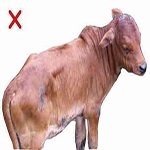 A malnourished animal
A malnourished animal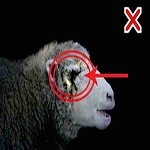 A one-eyed sheep
A one-eyed sheep A limping sheep
A limping sheep- Al-Batraa’: that which is tailless.
- Al-Jammaa’: that which is naturally hornless .
- Al-Khasiyy: a castrated sheep.
- Other deformities: An animal that has a cleft or a notch in its ear, or a crack on its horn.
The above statements on eligibility and deformities of animals for sacrifice are also applicable to Fidyah and Had-y.
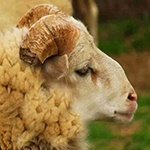 A break in the horn
A break in the horn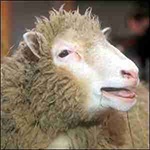 A hornless sheep
A hornless sheep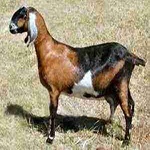 A tailless goat
A tailless goatIt is legislated that the owner of the animal eats a third, gives a third as a gift, and gives the remaining third as sadaqah; if he gives all as sadaqah, it is permissible; as is the case if he eats most of it.